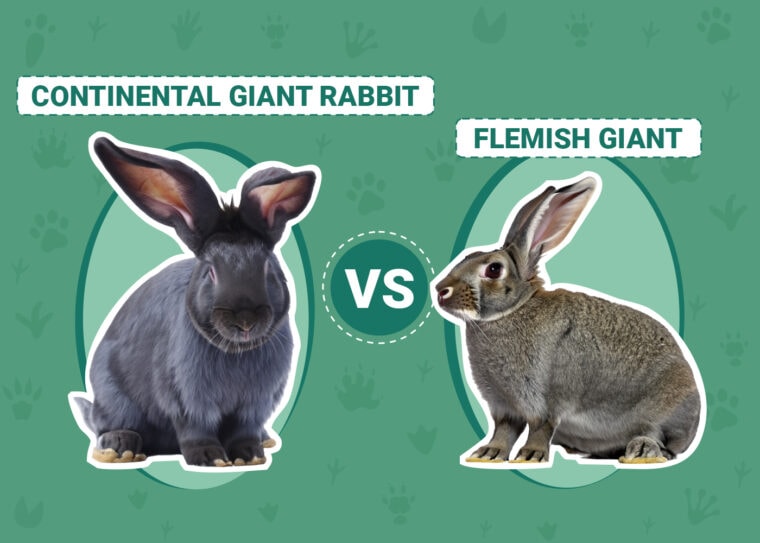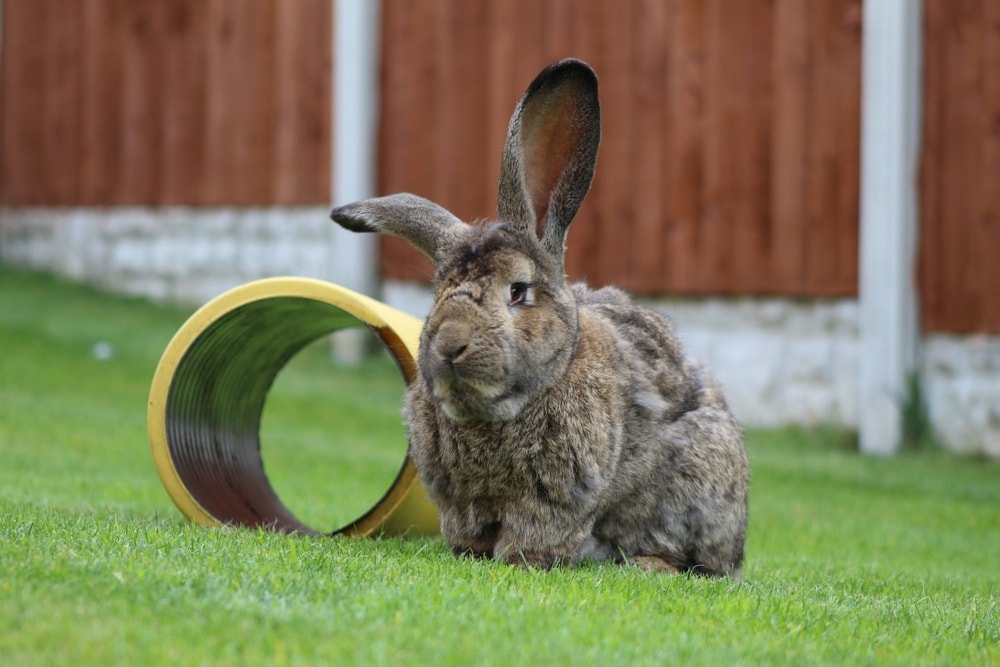
Click to Skip Ahead
When it comes to the world of large rabbit breeds, the Continental Giant Rabbit and the Flemish Giant are two of the biggest, as well as the most popular to keep as pets. If you are thinking about getting a rabbit for your home and are struggling to decide between these two amazing breeds, keep reading as we examine each one and tell you about their personalities, care needs, and how much exercise they should get.
Visual Differences

At a Glance
- Average height (adult): 24–28 inches
- Average weight (adult): 16–22 pounds
- Lifespan: 5–10 years
- Exercise: 1+ hours a day
- Grooming needs: Moderate
- Family-friendly: Yes
- Other pet-friendly: Often
- Trainability: Intelligent
- Average height (adult): 20–24 inches
- Average weight (adult): 13–15 pounds
- Lifespan: 5–8 years
- Exercise: 2+ hours a day
- Grooming needs: Easy
- Family-friendly: Yes
- Other pet-friendly: Often
- Trainability: Intelligent and willing to learn
 Continental Giant Rabbit Overview
Continental Giant Rabbit Overview

Personality / Character
Owners of Continental Giant Rabbits describe them as friendly and docile. They enjoy the companionship of their human caregivers and tend to be relaxed and laidback, making them pleasant and easy to handle. They have a curious nature and love to explore their environment, so allowing them time to roam free is essential. They can adjust to different living environments and get along well with other pets if you introduce them slowly.
Appearance
The Continental Giant Rabbit is quite large, with some rabbits reaching 25 pounds, and they have a strong, muscular build. The body is long and slender, though, and they have large ears that can be 7–8 inches long. Their fur is dense and soft and comes in several colors and patterns, including white, black, blue, steel, and various shades of agouti. Their eyes are dark and they have large, strong paws.
Training
Continental Giant Rabbits are trainable but require plenty of patience, consistency, and positive reinforcement. They like to explore, so keeping them focused on the session can be difficult. Holding your training sessions after playtime can help, but it can still take several weeks for your rabbit to learn a new trick.

Suitable For:
While Continental Giant Rabbits are friendly and docile, their large size means they have special care requirements, making them better suited to experienced rabbit owners. They also need a large habitat and plenty of space to move around, so they won’t be happy in a small apartment or home. However, they can make fantastic pets if you have the space, experience, and time to devote to playtime and grooming.
Flemish Giant Overview

Personality / Character
The Flemish Giant rabbit is gentle and friendly, with a laidback nature. They are tolerant and patient, making them a great choice for children. They are also playful and energetic, so they can be entertaining to watch as they explore their environment. They tend to be quiet, which can make them suitable for environments where noise is a concern, and they can adapt to various house settings.
Appearance
Like the Continental Giant, the Flemish Giant is quite large, often weighing 15 pounds or more. They have broad chests, strong shoulders, and a solid frame, giving them a sturdy and substantial appearance. Their ears are 5–7 inches long, and their soft, dense fur comes in many colors, including black, blue, fawn, sandy, white, and shades of gray. Some may have solid colors, while others may have patterns or markings.
Training
Flemish Giants are intelligent and willing to learn, so it can be fun to teach them new tricks, including how to use a litter box, which will make cleaning their environment easier. Hold your training sessions after playtime, and keep them short and consistent for the best chance of success.

Suitable For:
Like the Continental Giant, the Flemish Giant is best suited to experienced rabbit owners who have experience caring for rabbits, as their needs are greater because of their large size. They need a spacious enclosure or living area, so apartments or small homes may not be large enough. They also injure easily, so you must supervise them closely when they’re interacting with children. They also need to spend time out of their habitat, so you must set aside time each day to let them play.
Which Breed Is Right for You?
The Continental Giant and Flemish Giant are both amazing animals that can make great pets for someone with the space to house them. They are friendly, docile, and patient with children and enjoy being near their caregivers. They are fun to watch and smart enough to learn several tricks. If you are looking for a trainable rabbit, the Flemish Giant is a little more willing to be trained and may learn new tasks faster. If you are looking for a bigger rabbit, go for the Continental Giant.
See also:
- How Much Does A Continental Giant Rabbit Cost? (Price Guide)
- Male Vs. Female Rabbit: Differences Explained (With Pictures)
Featured Image Credit: Top – J A Photography, Shutterstock | Bottom – Best dog photo, Shutterstock

 Continental Giant Rabbit Overview
Continental Giant Rabbit Overview





